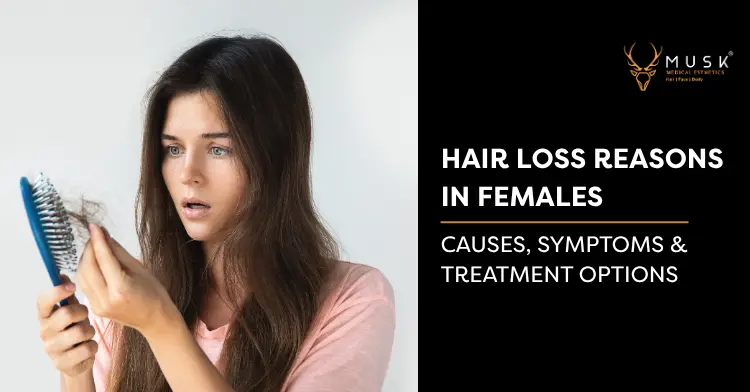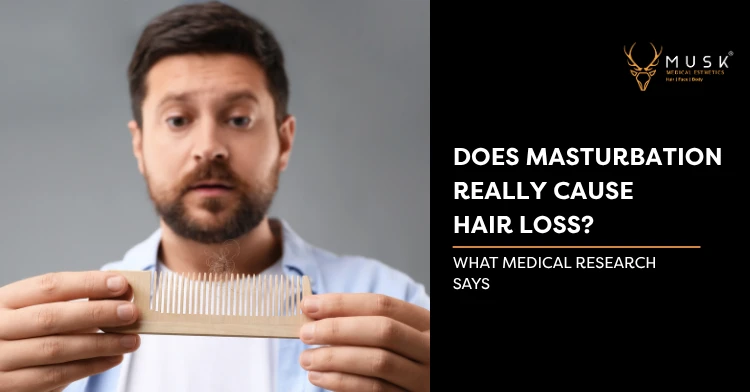How to Reverse Balding: Proven Ways to Regrow Hair

If you've noticed your hairline creeping back or found more hair in your shower drain than on your head, you're not alone. Hair loss affects 85% of men and 55% of women at some point in their lives, making it one of the most common health concerns people face today.
The good news? We're living in the most exciting time for hair restoration in decades. From breakthrough molecules that can literally wake up sleeping hair follicles to advanced transplant techniques, the options for reversing balding have never been more promising.
Let's cut through the noise and explore what actually works, what's coming next, and how you can take control of your hair loss journey today.
Ever Wonder Why You're Losing Hair - and how can you reverse balding?
Before diving into solutions, it's crucial to understand why you're losing hair in the first place. Think of it like this: you wouldn't try to fix a leaky roof without knowing where the water is coming from.
The Science Behind Pattern Baldness
Most hair loss - about 95% in men and a significant portion in women is caused by androgenetic alopecia, commonly known as male or female pattern baldness. Here's what happens:
Your hair follicles become increasingly sensitive to dihydrotestosterone (DHT), a hormone derived from testosterone. DHT binds to follicles, causing them to shrink progressively. Over time, these miniaturized follicles produce thinner, shorter hairs until they eventually stop producing visible hair altogether.
But here's the key insight that's driving new treatments: the follicles don't actually die. They go dormant. This means there's potential to reactivate them and that's exactly what the latest breakthrough treatments are designed to do.
Other Common Causes of Hair Loss
- Stress and illness (telogen effluvium)
- Nutritional deficiencies (iron, protein, vitamins)
- Hormonal changes (pregnancy, menopause, thyroid issues)
- Medications (blood thinners, antidepressants, chemotherapy)
- Autoimmune conditions (alopecia areata)
- Physical trauma to hair (tight hairstyles, harsh chemicals)
- Understanding your specific type of hair loss is essential because different causes require different approaches. What works for DHT-related balding won't necessarily help with nutritional deficiency-induced thinning.
What Treatments Are Actually Backed by Science and The FDA to reverse balding?
Let's start with what's proven and available right now. These treatments have decades of research behind them and represent the gold standard of hair loss therapy.
Minoxidil: The Blood Flow Booster
- How it works : Originally developed as a blood pressure medication, minoxidil improves blood flow to hair follicles and can extend the growth phase of the hair cycle.
- Effectiveness : Studies show 30-40% of users experience moderate to significant regrowth, with best results on the crown area.
- What to expect :
- Available over the counter as Rogaine or generic versions
- Comes in 2% and 5% concentrations (5% typically more effective)
- Must be used consistently, stop using it, and any regrown hair falls out
- Results typically visible after 3-6 months of consistent use
Real talk: Minoxidil works best for maintaining existing hair and can produce some regrowth, but it's not a miracle cure. It's often most effective when combined with other treatments.
Finasteride: The DHT Blocker
- How it works: Finasteride blocks the enzyme (5-alpha-reductase) that converts testosterone to DHT, reducing DHT levels by up to 70%.
- Effectiveness: Clinical studies show 80-90% of men maintain their hair, with 60-65% experiencing some regrowth over two years.
What to expect :
- Prescription-only oral medication
- One daily pill (1mg for hair loss)
- Most effective for crown and mid-scalp areas
- Results become apparent after 3-6 months, peak at 1-2 years
Important considerations: Finasteride can have side effects including decreased libido, erectile dysfunction, and mood changes in a small percentage of users (1-5%). These effects are usually reversible when stopping the medication.
Dutasteride: The Stronger Alternative
Similar to finasteride but blocks both types of 5-alpha-reductase enzymes, potentially making it more effective. It's approved for hair loss in some countries and is increasingly prescribed off-label in the United States.
What Are the Latest Hair Regrowth Breakthroughs in 2025 to reverse balding?
Here's where things get really exciting. Recent years have brought us closer to truly revolutionary hair loss treatments than ever before.
The UCLA Breakthrough: PP405 Molecule
This might be the biggest hair loss news in decades. UCLA researchers have identified a small molecule called PP405 that can wake up dormant hair follicles.
- How it works: PP405 targets a protein in follicle stem cells that keeps them dormant. By inhibiting this protein, the stem cells activate and begin producing hair again.
- The exciting part: Early human trials showed "statistically significant" results after applying PP405 topically to the scalp at bedtime for just one week. The researchers believe it will produce full terminal hair, not just peach fuzz.
- Current status: The research team has founded Pelage Pharmaceuticals (backed by Google Ventures) and raised $16.4 million to move toward FDA approval. While promising, it's still years away from commercial availability.
JAK Inhibitors: Treating Autoimmune Hair Loss
What they are: Drugs that target the JAK-STAT signaling pathway, reducing inflammation that causes the immune system to attack hair follicles.
- Best for: Alopecia areata (patchy hair loss) and severe cases have shown dramatic results in clinical trials.
- FDA status: Baricitinib (Olumiant) was recently approved for severe alopecia areata, marking a major breakthrough for this condition.
Stem Cell Therapy: Regenerating Hair Follicles
While still experimental, stem cell treatments are showing promise in early studies:
Types available:
- Autologous stem cell therapy: Using your own stem cells from fat tissue
- Hair follicle stem cell activation: Stimulating existing stem cells in follicles
- 3D organoid culture: Growing hair follicles in lab conditions (still highly experimental)
Current evidence: Small studies have shown increased hair density, but larger clinical trials are needed to establish safety and effectiveness.
Can Non-Invasive Treatments Help You Regrow Hair Without Surgery?
Platelet-Rich Plasma (PRP) Therapy
PRP has gained significant traction as a natural approach to hair restoration.
The process:
- Blood is drawn from your arm
- Platelets are concentrated using a centrifuge
- Concentrated platelets are injected into the scalp
- Growth factors in platelets stimulate hair follicles
- What the research shows: Multiple studies indicate PRP can increase hair density and thickness, particularly when combined with other treatments.
- Treatment schedule: Typically requires 3-4 initial sessions spaced 4-6 weeks apart, followed by maintenance treatments every 6-12 months.
- Best candidates: People with early-stage hair loss who still have some existing hair respond best.
Low-Level Laser Therapy (LLLT)
- How it works: Red light therapy at specific wavelengths (typically 630-670 nm) appears to stimulate cellular activity in hair follicles, increasing blood flow and potentially extending the growth phase.
Device options:
- In-office treatments (usually stronger devices)
- At-home laser caps, helmets, or combs
- Treatment typically requires 20-30 minutes, 3 times per week
- Effectiveness: Studies show modest improvements in hair density and thickness, particularly when used alongside other treatments.
Thinking About a Hair Transplant? Here's What You Should Know
When other treatments aren't enough, hair transplantation remains the most reliable method for restoring hair in bald areas.
Modern Hair Transplant Techniques
Follicular Unit Extraction (FUE):
- Individual follicles are harvested from donor areas
- Minimally invasive with tiny punch tools
- No linear scar, faster healing
- Can be combined with robotic assistance for greater precision
- NeoGraft: Automated FUE system for consistent extraction
- DHI (Direct Hair Implantation): Follicles implanted immediately without creating recipient sites first
- Sapphire FUE: Uses sapphire blades for more precise incisions
What to Expect from Modern Hair Transplants
Timeline:
- Surgery: 4-8 hours depending on graft count
- Initial healing: 7-10 days
- Transplanted hair falls out: 2-4 weeks (this is normal!)
- New growth begins: 3-4 months
- Significant results: 8-12 months
- Final results: 12-18 months
- Adequate donor hair supply
- Realistic expectations
- Choosing an experienced surgeon
- Following post-operative care instructions
What if Growing Your Hair Back Is Just a Few Habits Away?
While not replacements for medical treatments, these approaches can support overall hair health and may slow hair loss.
Nutrition for Hair Health
Your hair follicles are among the most metabolically active in your body, making them sensitive to nutritional deficiencies. .
Key nutrients:
- Iron: Essential for hair growth; deficiency is a common cause of hair loss in women
- Protein: Hair is primarily made of keratin, a protein
- Zinc: Plays a crucial role in hair tissue growth and repair
- Biotin and B vitamins: Support keratin production
- Vitamin D: Receptors in hair follicles suggest it plays a role in hair cycling
- Omega-3 fatty acids: May reduce inflammation around follicles
Food sources:
- Lean proteins (chicken, fish, eggs, legumes)
- Leafy greens and colorful vegetables
- Nuts and seeds
- Fatty fish
- Sweet potatoes
- Berries
Scalp Health and Massage
Scalp massage benefits:
- Increases blood flow to hair follicles
- May help reduce DHT levels locally
- Reduces stress (which can contribute to hair loss)
- Improves the health of the scalp environment
How to do it: Use fingertips (not nails) to apply gentle pressure in circular motions for 5-10 minutes daily. You can do this dry or with oils like rosemary or peppermint.
Stress Management
Chronic stress can push hair follicles into the resting phase prematurely, leading to increased shedding.
- Effective stress reduction techniques:
- Regular exercise
- Meditation or mindfulness practices
- Adequate sleep (7-9 hours nightly)
- Social connections and support
- Professional counseling when needed
What is the Future of Hair Regrowth?
Hair Cloning and Follicle Regeneration
Scientists in multiple countries are working on growing hair follicles in laboratory conditions, then transplanting them to bald areas. While promising in animal studies, human applications are still years away. .
Gene Therapy
Researchers are exploring ways to modify genes associated with hair loss sensitivity, potentially offering a one-time treatment that could prevent or reverse balding.
Advanced Topical Formulations
New delivery systems are being developed to get active ingredients deeper into the scalp and hair follicles, potentially making treatments more effective.
How Do You Choose the Right Hair Regrowth Plan for You?
With so many options available, how do you choose the right approach? Here's a systematic method used by hair restoration specialists: .
Step 1: Accurate Diagnosis
Professional evaluation includes:
- Medical history review
- Physical examination of scalp and hair
- Possible blood tests to rule out underlying conditions
- Trichoscopy (magnified scalp examination)
- Discussion of family history and lifestyle factors
Step 2: Set Realistic Goals
Consider:
- Current extent of hair loss
- Age and likely progression
- Budget and time commitment
- Tolerance for side effects
- Maintenance requirements
Step 3: Staged Treatment Approach
Moderate hair loss:
- Continue medical treatments
- Consider more aggressive PRP protocols
- Evaluate for hair transplant candidacy
- Explore combination therapies
Moderate hair loss:
- Continue medical treatments
- Consider more aggressive PRP protocols
- Evaluate for hair transplant candidacy
- Explore combination therapies
Advanced hair loss:
- Hair transplantation may be primary option
- Medical treatments to protect remaining hair
- Scalp micropigmentation as alternative or complement
- Newer experimental treatments as they become available
What to Avoid: Common Hair Loss Myths and Scams
The hair loss industry is unfortunately filled with questionable products and false promises. Here's what to watch out for:
Red Flags
- Miracle cures promising overnight results
- Undisclosed ingredients or "proprietary blends"
- Testimonials without clinical data
- High-pressure sales tactics
- Treatments not offered by licensed medical professionals
Treatments with Limited Evidence
- Most hair growth shampoos (though some may help with scalp health)
- Expensive supplement cocktails
- Unproven devices claiming to use "advanced technology"
- Essential oil treatments (while some show promise, evidence is limited)
When to Seek Professional Help
You should consult a healthcare provider or hair loss specialist if: You're losing more than 100-150 hairs per day consistently
- You notice sudden, patchy hair loss
- Hair loss is accompanied by scalp irritation, pain, or unusual symptoms
- You're experiencing significant emotional distress about hair loss
- Over-the-counter treatments haven't helped after 6-12 months
- You're considering prescription medications or procedures
How Hair Loss Messes With Your Confidence?
Hair loss can significantly impact self-esteem and quality of life. Studies show that people experiencing hair loss often report:
- Decreased confidence in social situations
- Concerns about appearing older
- Anxiety about continued hair loss
- Impact on professional self-image
Remember: These feelings are completely normal and valid. Hair loss treatment isn't vanity it's about feeling confident and comfortable in your own skin.
How Hair Loss Messes With Your Confidence?
Hair loss can significantly impact self-esteem and quality of life. Studies show that people experiencing hair loss often report:
- Decreased confidence in social situations
- Concerns about appearing older
- Anxiety about continued hair loss
- Impact on professional self-image
Remember: These feelings are completely normal and valid. Hair loss treatment isn't vanity it's about feeling confident and comfortable in your own skin.
Ready to Take Control of Your Hair Again? Start Here
Immediate Steps (This Week)
- Document your hair loss: Take photos from multiple angles in good lighting
- Track your hair loss pattern: Note where you're losing hair and how quickly
- Review your medications: Check if any could be contributing to hair loss
- Assess your stress levels: Consider recent life changes or ongoing stressors
Short-term Actions (This Month)
- Schedule a consultation with a qualified provider
- Get baseline blood work if recommended
- Research treatment options that fit your budget and lifestyle
- Start scalp health practices (gentle massage, proper nutrition)
Long-term Commitment (Next 6-12 Months)
- Begin appropriate treatments based on professional recommendations
- Track progress with regular photos and notes
- Maintain consistency with chosen treatments
- Adjust approach based on results and new developments
Can You Really Beat and reverse Balding - or Is That Just a Dream?
We're living in an unprecedented time for hair loss treatment. From proven medications to breakthrough research, the options continue to expand. While we don't yet have a universal "cure" for baldness, we have more tools than ever to slow, stop, and in many cases reverse hair loss.
Key takeaways:
- Early intervention typically yields better results
- Combination approaches often work better than single treatments
- Consistency is crucial for success
- Professional guidance helps optimize results and minimize risks
- New treatments continue to emerge, offering hope for the future
The most important step is the first one: acknowledging your hair loss and deciding to take action. Whether that's starting with proven medical treatments, exploring cutting-edge therapies, or considering surgical options, the journey to hair restoration begins with a single decision.
At Musk Clinic, we understand that hair loss can be a sensitive and complex issue that affects not just your appearance, but your confidence and quality of life. Our team of experienced professionals specializes in diagnosing and treating various types of hair loss, using the latest research and cutting-edge treatments tailored to your individual needs.
Remember, it's never too late to start taking better care of your hair. With the right professional guidance and treatment approach, you can work towards maintaining and restoring a healthy, full head of hair for years to come.
If you're ready to take the next step in addressing your hair loss concerns, we invite you to schedule a consultation with our experienced team. We're here to listen, understand your unique situation, and help you explore the best options available for your specific needs.
Contact Musk Clinic today to begin your personalized hair restoration journey.











